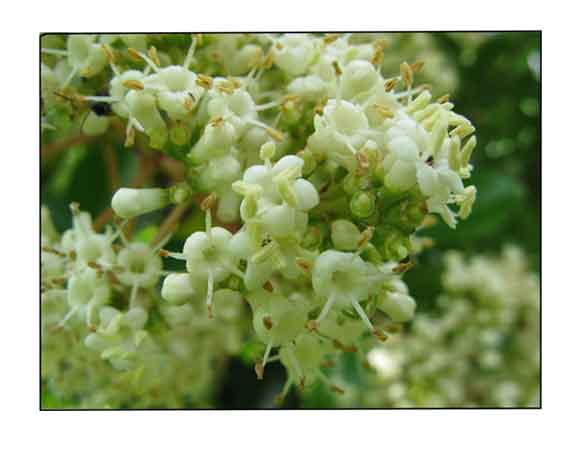 Gen info Gen info
- Viburnum is a large group of more than 150 species and numerous cultivars, which include deciduous and evergreen shrubs and small trees,
- Previously belonging to the family Caprifoliaceae, it has been recently moved to the family Adoxaceae.
-
The word "coral" in the Chinese name "Coral Tree" refers to the red fruit.
- The Igorot name "apiit" refers to the "smell of chicken being cooked by boiling", which is unpleasant to some.
- The species is often confused with Viburnum japonicum and V. awabuki.
- "Emerald lustre" has pink tinged new growth, with lustrous green mature leaves.
Botany
Viburnum odoratissimum is a shrub or small evergreen tree, up to 10-15 m tall. Bark is grayish brown with raised tuberculate lenticels. Branchlets green or reddish, glabrous or sometimes sparsely yellowish-brown stellate pubescent. Leaves are elliptic, oblong to obovate, leathery, opposite; margins irregularly or shallowly undulate-serrate at the upper part, or subentire; adaxially dark green and glossy,abaxially sometimes sparsely with dark-red small glands, often with tufted brown hairs aggregating at axils of veins; lateral veins and midveins conspicuously raised abaxially. Flowers are fragrant. Inflorescences terminal, pyramidal. Rotate corolla white, later turning yellowish white or reddish. Lobes ovate-orbicular, reflexed. Fruits are drupes, ovoid-ellipsoid, red when young, turning black when mature, and contains a single large seed. (1)
Distribution
- Native to the Philippines.
- Also native to China, Korea, Taiwan, Japan, the Himalayan region in India. Myanmar, Thailand, and Vietnam.
- Cultivated as garden ornamental.
Constituents
- Bioassay-directed fractionation of methanolic extract of flowers and leaves of V. odoratissimum isolated two new diterpenes, vibsanol A and B (1,2), along with two new triterpenoids. 6ß-hydroxylup-20(29)-em-3-oxo-27,28-dioic acid (3) and 6α-hydroxylup-20(29)-en-3-oxo-27,28-dioic acid (4), and known terpenoids vibsanins B and E, and 6α-hydoxylup-20(29)-en-3-oxo-28-oic acid. (see study below) (6)
- Volatiles in flowers consist of esters, alkanes, ketones, alcohols, aldehydes, and acids. Main compounds in flowers are methyl o-anisate, heneicosane, methyl salicylate, 1-[2-(1-hydroxy-1-methylethyl)cyclopropyl] ethanone,
Triterpenes and trans-phytol fatty alcohol have been detected in the roots. (9)
Properties
- Studies have suggested antioxidant, antibacterial, cytotoxic, antitumor, neuroprotective, insecticidal properties.
Parts used
Leaves, seeds, bark.
Uses
Edibility
- Fruit is edible.
Folkloric
- In Kabayan, Benguet, boiled leaves and stems used for treating sore eyes.
-
Leaves ground to a paste are applied to bruises, swelling and fractures. (1)
- In China, decoction of whole plant parts used for treatment of rheumatism. (10)
Others
- Wood: Used as material for fine woodworking.
- Agroforestry: Used as background planting as a screen, hedge, or wind-break in open areas. At maturity, provides a dense, multibranched rounded canopy. Attracts nectar eating birds and insects.
Studies
• Antioxidant / Seeds: Study evaluated the antioxidant activities of crude extract and four fractions of seeds of V. odoratissimum. The n-butanol-soluble fraction (BF) was the richest fraction in total flavonoids and total phenolic. The ethyl acetate-soluble fraction and BF showed good superoxide radical scavenging activity and reducing power. A petroleum ether soluble fraction showed highest inhibition of lipid peroxidation activity. There were statistically significant correlations between antioxidants and antioxidant activities. (5)
• Vibsane Diterpenes and Lupane Triterpenes / Cytotoxicity / Human Gastric Tumor Cells / Leaves and Flowers: Bioassay-directed fractionation of methanolic extract of flowers and leaves of V. odoratissimum isolated two new diterpenes, vibsanol A and B (1,2), along with two new triterpenoids (3,4), and known terpenoids. Vibsanol A (1) and compound 3 exhibited significant cytotoxicity against human gastric (NUGC) tumor cells. (see constituents above) (6)
• Neuroprotective / Terpenoids / Leaves: Study of leaves isolated two new iridoid glycosides, vibsansuspenside A-B (1-2) along withe five known terpenoids (3-7). Compounds were evaluated for neuroprotective effects against H2O2-induced damage in human dopaminergic neuroblastoma cells (SH-SY5Y). Compound 3 exhibited the most potent neuroprotective activity and can protect SH-SY5Y cells from oxidative damage through inhibiting cell apoptosis. (7)
• Inhibition of Melanin Synthesis and Cell Proliferation of B16 Melanoma Cells / Seed and Bark: Methanol extracts of V. odoratissimum wood and bark inhibit4d melanin biosynthesis and cell proliferation of B16 melanoma cells at 100 and 50 µg/ml, respectively (Shimizu et al, 2007). (9)
• Insecticidal / Methyl Salicylate / Soil Rhizosphere: Methyl salicylate produced by Viburnum odoratissimum is known to exert lethal or sublethal effects on insects. Study evaluated the behavioral and toxicological responses of red imported fire ant (RIFA Solenopsis invicta) (Hymenoptera: Buren Formicidae) at different soil depths in the rhizosphere of V. odoratissimum. Results of insecticidal activity bioassays indicated mortality for minor and major ants in soil under V. odoratissimum at depths of 0-10 cm exhibited excellent insecticidal effect in controlling RIFA. (11)
Availability
- Wild-crafted.
- Cultivated. |

 Gen info
Gen info![]()



